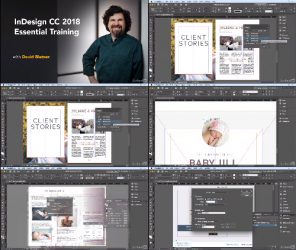

- #DAVID BLATNER INDESIGN CC 2017 ESSENTIAL TRAINING COURSE HOW TO#
- #DAVID BLATNER INDESIGN CC 2017 ESSENTIAL TRAINING COURSE PLUS#
But whatever you do, make sure you name your colors appropriately. It's much better to pick CMYK colors from an already printed swatch book such as the True match or Pantone books and then type the values that the swatch book tells you to. Now I do need to point out that you should be very careful when picking colors on your screen, because the colors that you see on screen are probably not going to match what you see in print, believe me, I've been burned by that one myself. I just move these sliders around but you could type in actual CMYK values if you want. In this case, I'm going to leave it set to CMYK, then I can just choose a color here. Now, generally, if your document is going to be printed you probably want your color mode to be set to CMYK, on the other hand, if your document is mostly for onscreen viewing and maybe it's going to be printed to a desktop printer then an RGB color would be fine, or you could choose HSB which is technically another way of specking an RGB color. So let's go ahead and change the color mode back to something else like CMYK, now I can change the color type back to process. Now in the vast majority of cases you're going to be creating process colors, not spot. CC libraries are cool because you can use them across, not just in design documents, but in Photoshop and illustrator and even some of Adobe's mobile apps but in this case, we don't want to do that, we just want it in this document so I'm leaving that turned off. I should also mention, that there's a checkbox down here at the bottom called add to CC library.

If I click add, it adds it to the swatches panel but the dialog box stays open so I can make another color. The difference is, that if I click okay, it adds that to the swatches panel and closes this dialog box.

Then you can choose from the menu here or just type the Pantone number here, like I like 286, so I'll type that, it show up in the menu here, and then I can click okay or add.
#DAVID BLATNER INDESIGN CC 2017 ESSENTIAL TRAINING COURSE PLUS#
Most people do not need spot colors but if you do want to make a spot color, then choose spot from the color type menu and then choose from the color mode menu, for example, I'll choose Pantone plus solid coated. Spot colors should only be used, if you're going to be printing on a printing press and you know that your printer is using special Pantone inks like spot inks or varnishes, things like that. Inside the new color swatch dialog box, the first thing you need to decide is whether you want a process or a spot color. Now, in the swatches panel menu in the upper right corner, choose new color swatch. Just click out here in the pasteboard or someplace where there's no objects to make sure that nothing is selected. When you create a new color swatch you should probably first de-select all the objects on your page. But what if you get tired of the colors listed here? What if you want something more? Well, let's look at how you can create a new color swatch for your document. And as we saw in an earlier movie, you can use it to apply fill and stroke colors to any object or text on your page.
#DAVID BLATNER INDESIGN CC 2017 ESSENTIAL TRAINING COURSE HOW TO#
David Blatner shows how to navigate and customize the InDesign workspace, build strong and flexible master pages, work with text and graphics, export and print finished documents, create interactive PDFs, and much more.- The swatches panel over here in the dark is central headquarters for your documents colors. Watch the quick-start chapter to learn InDesign in just 30 minutes, or explore the entire course. InDesign CC Essential Training presents a thorough explanation of the core features and techniques that make this powerful page-layout application fun and easy to use, providing a foundation upon which advanced skills and workflows can be built. InDesign is an essential tool for design firms, ad agencies, magazines, newspapers, book publishers, and freelance designers around the world. Genre: eLearning | Level: Beginner | Language: English


 0 kommentar(er)
0 kommentar(er)
